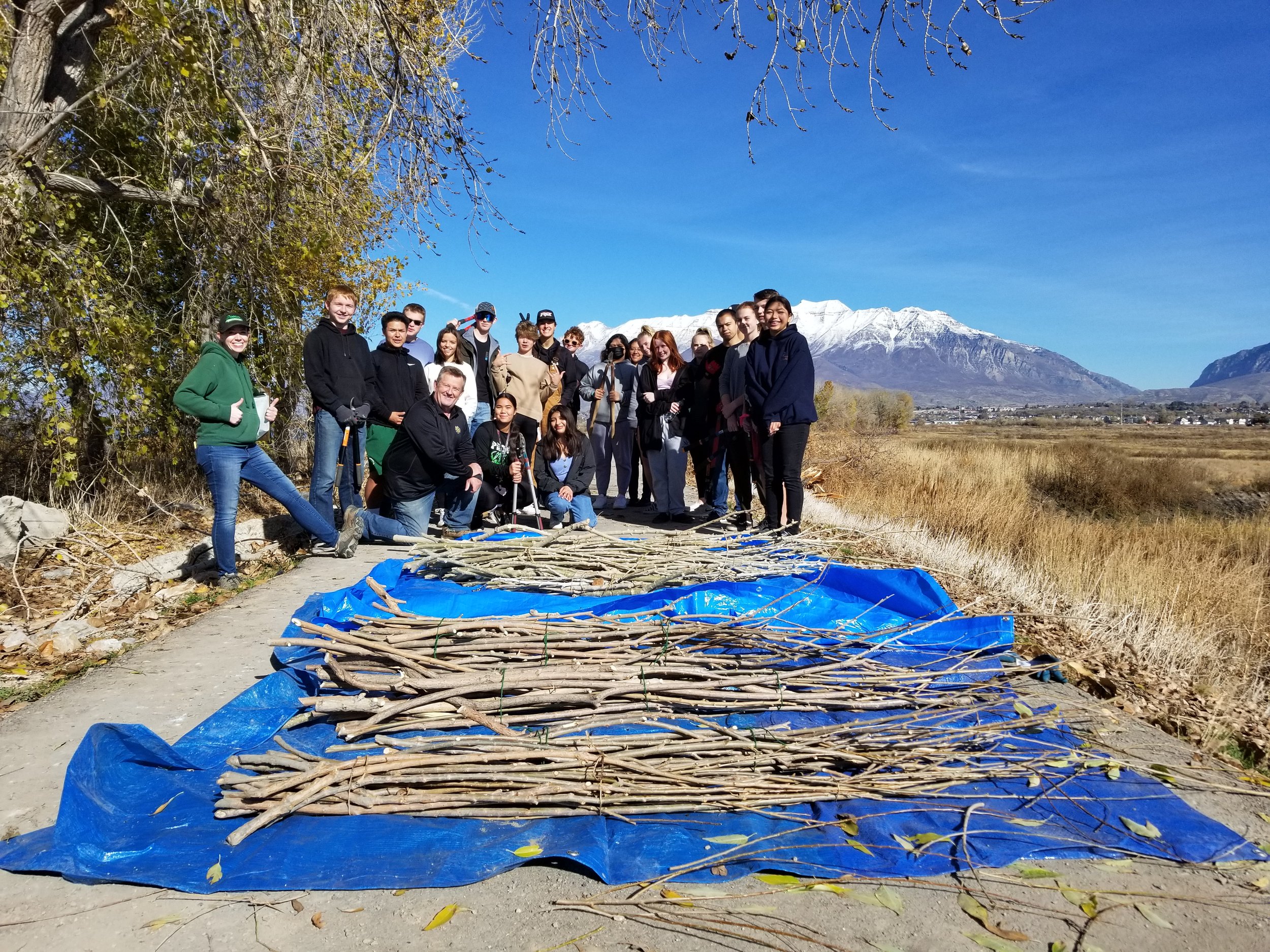Provo River Delta Restoration Project
2021 A Year in Review
2021 was a busy year on the Provo River Delta and a lot has been accomplished.
Construction Progress
Although construction on the Provo River Delta Restoration Project will not be fully complete until 2024, major excavation of pond and river channel features is already over 70% complete. Over 3.5 miles of new river channel has been constructed and 35 acres of excavated ponds and wetland features. Much of the excess fill material generated from excavating delta ponds and channels has been loaded into trucks and hauled to Provo’s future Regional Sports Park site through a partnership with the Provo Parks Department. To document construction progress we acquired aerial imagery of the project area last November 2020, and again in November 2021. Compare the two images above to see the tremendous amount of work accomplished this past year!
Planting and Revegetation Efforts
Planting bank of an excavated pond
During each year of project construction an aggressive seeding and planting effort is undertaken in disturbed areas to establish native plants. Conditions were ideal for planting this past fall. A total of 57,815 riparian and emergent plantings were installed by North Fork and Spring Creek Nurseries. Primary planting areas in 2021 were riparian mounds, new islands, low benches, pond banks, and areas with a high water-table that will be well-suited for trees/shrubs in the future.
We are grateful to Utah Division of Wildlife Resources crews who helped acquire and spread native seed on 10 acres of disturbed wetland, riparian and upland areas at the delta, while also investing 568 person- hours of labor treating invasive weeds during 2021.
UDWR Seeding Riparian Mounds
Seeding the bank of newly constructed river channel
Ute Ladies’-tresses
New channel construction is taking place in a few areas that are known to support Ute ladies’-tresses, a rare orchid listed as threatened under the Endangered Species Act. These areas could not be avoided by modifying the project design. The Provo River Delta project will ultimately provide additional Ute ladies’-tresses habitat once it’s complete, but in the interim, project impacts to habitat are being mitigated by carefully excavating and transplanting sod containing Ute ladies’-tresses to new locations in the project area that will provide favorable habitat for the orchid.
Careful excavation and transplant of sod containing Ute ladies’-tresses
Changing Water Conditions
Irrigation equipment deployed on the project
While soil moisture conditions were excellent for planting this past fall, 2021 was an historically dry water year. Dry conditions in the project area made it easier for heavy construction equipment to work, but more challenging for keeping fresh plantings alive. Supplemental irrigation equipment was deployed on site to help.
Conditions can change quickly. The map on the right shows aerial imagery acquired prior to starting delta construction; Utah Lake was full at an elevation of 4,489’. High groundwater levels in the project area served as a reminder that the area used to be a natural bay of Utah Lake. By contrast, as of early December 2021, Utah Lake was only about 52% full.
Delta Tours and Community Stewardship
Provo High School sudents harvesting willows for transplant
Over 22 tours and 20 stewardship events were hosted in the project area in 2021. Tours and stewardship events were organized with high school and university students, trail users, anglers, scouts, local community members, and other interested groups. Hundreds of visitors saw and learned firsthand about the emerging Delta.
Special thanks go to the Utah Conservation Corps crew who invested over 200 hours of sweat equity pulling invasive weeds thereby reducing the need to chemically treat them with herbicides in ecologically sensitive areas. Thanks also go out to the dozens of gung-ho community volunteers and students digging in to weed out invasive tamarisks and Russian Olives.
June Sucker Recovery
In February 2021, the U.S. Fish and Wildlife Service announced the June sucker had officially been downlisted from “endangered” to “threatened” status, recognizing the progress made toward recovery of the species. This accomplishment comes thanks to the June Sucker Recovery Implementation program (JSRIP), which has been working towards recovery of the species since 2002. While the downlisting is a great accomplishment, complete recovery and delisting remains the goal and there is still much work to do. The Provo River Delta Restoration Project will go a long way towards reaching that goal by providing essential habitat conditions currently lacking in the lower Provo River.
The larval stage is when June sucker are most vulnerable; predators, poor habitat, and low stream flows can all impact their survival. The delta project will improve habitat conditions for the larval life stage by providing warmer water, refuge from predators, and increased productivity compared to the existing river. Improving the larval survival rate will result in more June sucker surviving to become juveniles and eventually adults. Increased recruitment of new adults would be a big step towards recovery of the species.
June Sucker Spawning and Monitoring
Each year biologists track the June sucker spawning run to evaluate population status and effectiveness of recovery actions. A proportion of June sucker in Utah Lake are marked with a Passive Integrated Transponder (PIT) tag - basically a microchip that identifies the fish with a unique number. These tags are read as a tagged June sucker swim over readers placed in the Provo River, allowing the fish to be tracked without being handled. This year 4,228 June sucker were detected as they migrated up the Provo River to spawn, substantially higher than observations in recent years, which have been around 2,500.\
Bird Monitoring
The Provo River Delta Restoration Project area provides abundant habitat for many bird species. Because of its proximity to the Provo Airport, there is a concern that changing the habitats in the project area could alter the numbers, timing and patterns of bird use, and potentially increase the risk to aviation safety. To better understand and address this concern, project leaders hired a Federal Aviation Administration Certified Airport Wildlife Biologist to develop and conduct a bird monitoring and movement study with assistance from Brigham Young University, Department of Wildlife and Wildlands Conservation.
As shown in the screenshot on the right, where and when birds were observed are displayed as a heat map. Using the site’s filter tools, data can be narrowed to a specific species and to timeframes of 1-month intervals.
Since April 2017, 22 different sites have been monitored three times per week (once in the morning, once in the afternoon and once in the evening) for a period of 10 minutes each visit. Trained observers identify bird species, their location, observed activity, and direction of flight to help determine whether birds are using airspace within the flight patterns of Provo Airport aircraft.
The monitoring and movement study will provide baseline data on the abundance and movement patterns of bird species utilizing habitats in and around the project area and the Provo Airport.
In 2021, 286,206 birds were observed including 152 different bird species. However, over 75% of the observations were from just 6 species:
Looking Ahead to 2022
While much of our first two construction seasons focused on building ponds, wetlands and delta area river channels, work will transition to new construction phases in 2022. Starting in January, construction crews will take advantage of unusually low Utah Lake levels to construct the Provo River Delta outlet channels; four channels where Provo River flows will enter Utah Lake. This work was not scheduled to start until late summer 2022, but with the low lake level, it was moved forward to take advantage of favorable construction conditions. This means construction of river zone habitat (shown below) originally planned for this winter is postponed until after the outlet channels are done.



















